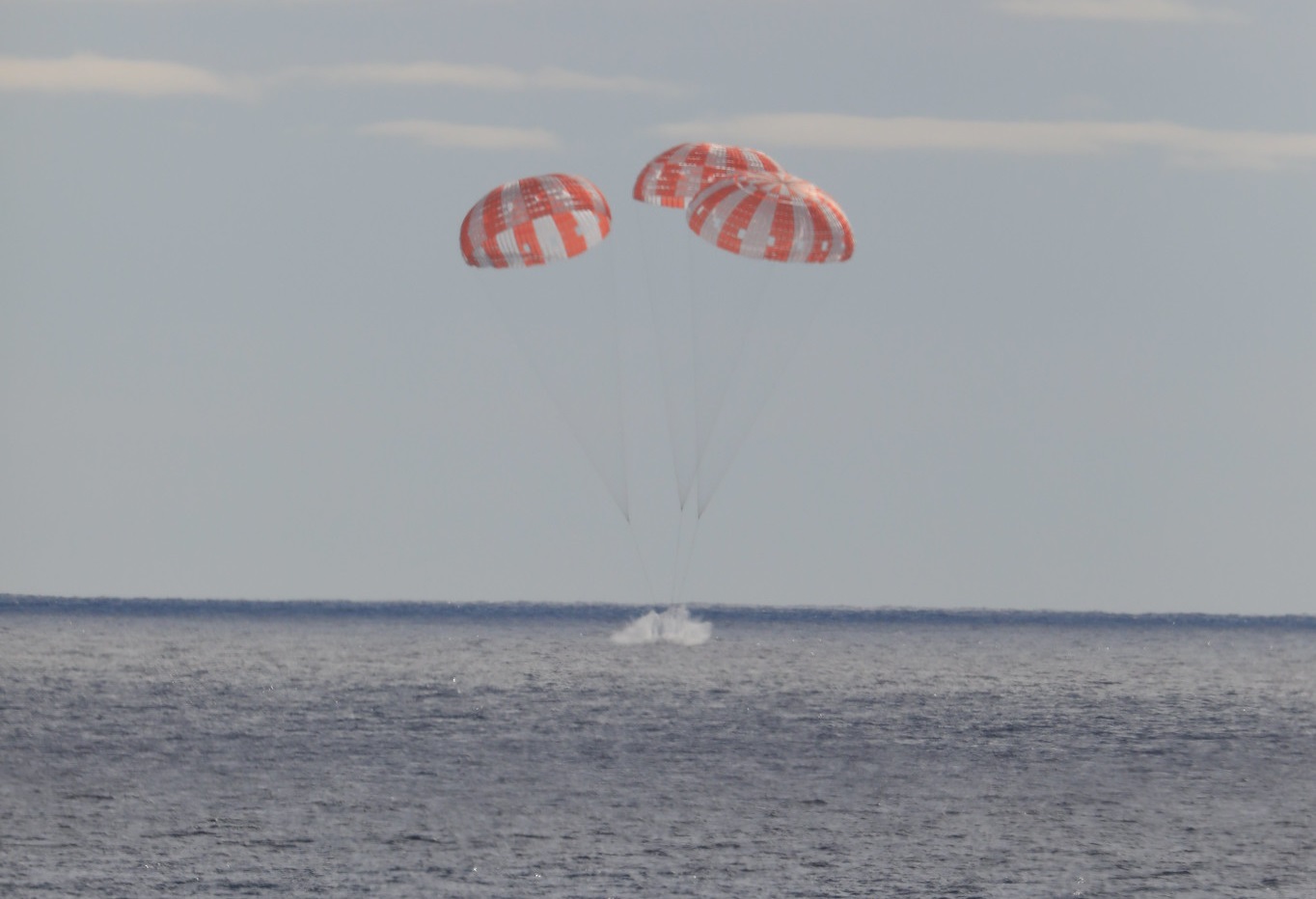On December 11th, at 09:40 a.m. PST (12:40 p.m. EST), NASA’s Artemis I mission splashed down in the Pacific Ocean off the coast of Baja California. The return of the uncrewed Orion spacecraft marks the end of the Artemis Program’s inaugural mission, which launched on November 16th and validated the spacecraft and its heavy launch vehicle – the Space Launch System (SLS). During its 25.5-day circumlunar flight, the Orion spacecraft traveled more than 2.25 million km (1.4 million mi) and flew beyond the Moon’s orbit, establishing a new distance record.
Just before reentering the Earth’s atmosphere, the crew module separated from the ESA-designed European Service Module (ESM), the power and propulsion element of the Orion spacecraft. Once it was in Earth’s atmosphere, the crew module successfully endured temperatures of about 2760 °C (5,000 °F), roughly half the surface temperature of the Sun. After about 20 minutes, the Orion craft slowed from a reentry speed of almost 40,230 km/h (25,000 mph) to about 32 km/h (20 mph) and deployed its parachutes for splashdown.
As NASA Administrator Bill Nelson said in a recent NASA press release:
“The splashdown of the Orion spacecraft – which occurred 50 years to the day of the Apollo 17 Moon landing – is the crowning achievement of Artemis I. From the launch of the world’s most powerful rocket to the exceptional journey around the Moon and back to Earth, this flight test is a major step forward in the Artemis Generation of lunar exploration.“
“It wouldn’t be possible without the incredible NASA team. For years, thousands of individuals have poured themselves into this mission, which is inspiring the world to work together to reach untouched cosmic shores. Today is a huge win for NASA, the United States, our international partners, and all of humanity.”
Flight controllers at NASA’s Johnson Space Center in Houston spent about two hours after splashdown performing tests in open water to gather additional data about the spacecraft. Recovery personnel then collected detailed imagery of the Orion spacecraft before hoisting it aboard the deck of the USS Portland – an amphibious transport dock ship of the U.S. Navy. The spacecraft will be transported to San Diego and is expected to arrive tomorrow (December 13th), with offloading expected on Thursday, December 15th.
From there, technicians will drive the capsule back to the Kennedy Space Center in Florida, where the mission payloads will be unloaded, and the capsule and heat shield will undergo months of testing and analysis. “Orion has returned from the Moon and is safely back on planet Earth,” said Artemis I mission manager Mike Sarafin. “With splashdown, we have successfully operated Orion in the deep space environment, where it exceeded our expectations and demonstrated that Orion can withstand the extreme conditions of returning through Earth’s atmosphere from lunar velocities.”
During its mission, the Artemis I spacecraft performed two lunar flybys, the first on its way beyond the Moon’s orbit and the second during its return to Earth. On December 5th, the spacecraft came within about 130 km (80 mi) of the Moon and took many breathtaking images of the lunar surface. At its farthest point, Artemis I traveled close to 434,525 km (270,000 mi) from Earth, the farthest distance achieved by a human-rated spacecraft and breaking the previous record of 400,170 km (248,655 mi) established by Apollo 13.
In addition, Artemis I spent more time in space than any human-rated spacecraft without docking with a space station – including the Salyut space stations, Skylab, Mir, and the International Space Station (ISS). The previous records were established by the Soyuz 9 mission in 1970 (~17 days and 17 hours) and the Gemini 7 mission in 1965 (13 days, 18 hours, and 35 mins). The purpose of sending farther into space and staying there longer than any previous spacecraft was to stress test the Orion in the harsh environment of deep space.
This effectively demonstrated how it will hold up during Artemis II (scheduled for May 2024), which will see it fly with a crew of four astronauts (to be named in 2023) as it conducts another circumlunar flight. This will be followed by Artemis III in 2025, which will send four astronauts to the Moon and land two of them (the first woman and person of color) on the surface for the first time since the Apollo 17 mission in 1972. By 2028, NASA plans to establish the Lunar Gateway in orbit around the Moon and the Artemis basecamp on the surface.
Artemis I was the first integrated test of all the flight elements that will send astronauts to the Moon for the first time since the closing of the Apollo Era over 50 years ago. This includes the Orion spacecraft, the SLS rocket, the supporting ground systems, and other elements that constitute NASA’s deep-space exploration systems. The mission was supported by thousands of people worldwide, ranging from the major companies that built the spacecraft, rocket, and infrastructure that launched them to international and academic partners and the smaller companies supplying subsystems and components.

The long-term objective, which NASA has had its eye on since 2010, is to use this infrastructure as a stepping stone to Mars by the early 2030s. Said Jim Free, NASA associate administrator for the Exploration Systems Development Mission Directorate (ESDMD):
“With Orion safely returned to Earth, we can begin to see our next mission on the horizon, which will fly crew to the Moon for the first time as a part of the next era of exploration. This begins our path to a regular cadence of missions and a sustained human presence at the Moon for scientific discovery and to prepare for human missions to Mars.”
Further Reading: NASA

